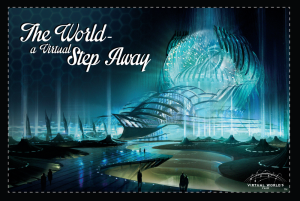The Virtual World’s Fair is where VR hype meets theme parks
 Earlier this year, Landmark announced that it would begin building VR-based attractions called Live Centers, starting with one in China in the summer of 2017. The centers would include a “virtual zoo,” digital art gallery, and various cinematic offerings, all contained in a 200,000-square-foot complex. As the company announced earlier this month, though, it’s also planning to launch at least two home virtual reality services in the next two years. If everything goes right, its VR apps — the self-contained “Pavilion of Me” and much larger “Virtual World’s Fair” — will put Landmark in the company of gaming companies, VR film studios, and software designers. But that’s a huge qualifier — and a sign of how little we really know about the future of VR.
Earlier this year, Landmark announced that it would begin building VR-based attractions called Live Centers, starting with one in China in the summer of 2017. The centers would include a “virtual zoo,” digital art gallery, and various cinematic offerings, all contained in a 200,000-square-foot complex. As the company announced earlier this month, though, it’s also planning to launch at least two home virtual reality services in the next two years. If everything goes right, its VR apps — the self-contained “Pavilion of Me” and much larger “Virtual World’s Fair” — will put Landmark in the company of gaming companies, VR film studios, and software designers. But that’s a huge qualifier — and a sign of how little we really know about the future of VR.
Based on which analyst prediction you happen to click in a Google search, the virtual reality industry will be worth $7 billion, $21.8 billion, or possibly $30 billion by 2020. Landmark predicts there will be 170 million active VR users by 2018. The ultra-simple Google Cardboard notwithstanding, most consumers today have yet to use the technology in any meaningful sense, but Christopher believes that the amount of high-profile support it’s gotten is a sure omen. "There’s too many very, very powerful organizations trying to launch this business for it not to happen," he says.
Both the Virtual World’s Fair and the Pavilion of Me (POM for short) are described as portals; the former is a digital theme park, the latter a personal entertainment complex. POM is slated to arrive first in the fall of 2016, after the launch dates of Oculus, Sony, and Valve’s high-end headsets — Landmark hasn’t officially announced launch platforms, but Christopher says there’s interest from Sony and Oculus. Right now, Landmark is showing off only a video of an early build, a series of separate "rooms" for activities like watching movies, holding Skype calls, lounging with friends, and looking through virtual versions of your old-fashioned photographs.
In other words, Landmark is building a VR user interface — a notoriously hard thing to get right.
See the full story here: http://www.theverge.com/2015/10/26/9615024/landmark-virtual-reality-worlds-fair-pavilion-of-me?curator=MediaREDEF
Pages
- About Philip Lelyveld
- Mark and Addie Lelyveld Biographies
- Presentations and articles
- Tufts Alumni Bio